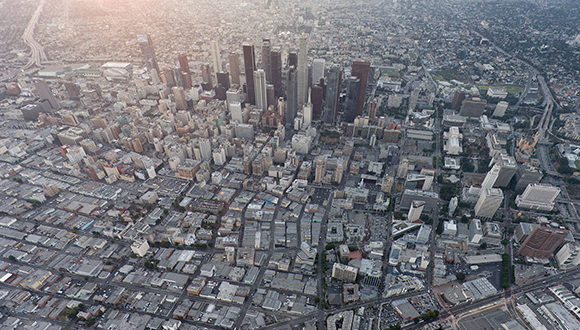California won't meet its climate change goals without a lot more housing density in its cities
Published on March 6th, 2017
By Liam Dillon
March 6, 2017
LA Times
To meet the bold new climate change goals put in place last year, California will work to put millions of electric cars on the road, revolutionize its dairy industry and generate half of all power from solar panels and other renewable sources.
But those efforts will come up short, warn state regulators, without dramatic changes to how Californians live and travel.
The state has pledged to reduce its greenhouse gas emissions to 40% below 1990 levels by 2030. To do so, Southern Californians will have to drive nearly 12% less by that date than they did five years ago, cutting their miles on the road every day from 22.8 to 20.2, according a Los Angeles Times estimate based on data from state and regional climate and planning officials.
These driving reductions mean that Californians will have to walk, bike and use mass transit much more frequently than they do now. By 2030, residents will have to travel by foot four times more frequently than they did in 2012, alongside a nine-fold increase in bicycling over the same time, and a substantial boost in bus and rail ridership, climate officials say.
Getting people out of their cars in favor of walking, cycling or riding mass transit will require the development of new, closely packed housing near jobs and commercial centers at a rate not seen in the United States since at least before World War II, according to a recent study by permit and contractor data analysis website BuildZoom.
“You can’t be pro-environment and anti-housing,” said Marlon Boarnet, chair of the Department of Urban Planning and Spatial Analysis at USC’s Price School of Public Policy, who has advised state climate regulators on land-use issues. “You can’t be anti-sprawl and anti-housing. This is something that has not been very well understood.”
The primary question in meeting the reduced driving goals, Boarnet and other planning experts said, is whether cities and counties will sign off on the massive amount of housing needed in already developed neighborhoods. Local governments, not the state, largely govern the approval of new housing.
Even now, the effort to shift development from suburban to urban areas is facing strong head winds. Across California, local resistance and an existing state environmental law that prioritizes car travel over mass transit have frustrated attempts to plan and build housing that will help the state meet its climate goals.
“We’re going to do our best, but I think it’s too ambitious, to be honest with you,” Ikhrata said.
California’s largest portion of greenhouse gas emissions comes from pollution generated by cars and trucks. Climate regulators want to cut traffic emissions by replacing gasoline-powered vehicles with electric versions — the goal is to have 40% of all new car sales be zero-emission vehicles by 2030 — and by vastly reducing the amount of carbon in fuel. But even if the state reaches those targets, the amount of pollution emitted from cars and trucks will still be too high to meet the state’s environmental targets. The only way to make up the difference is for people to drive less.





